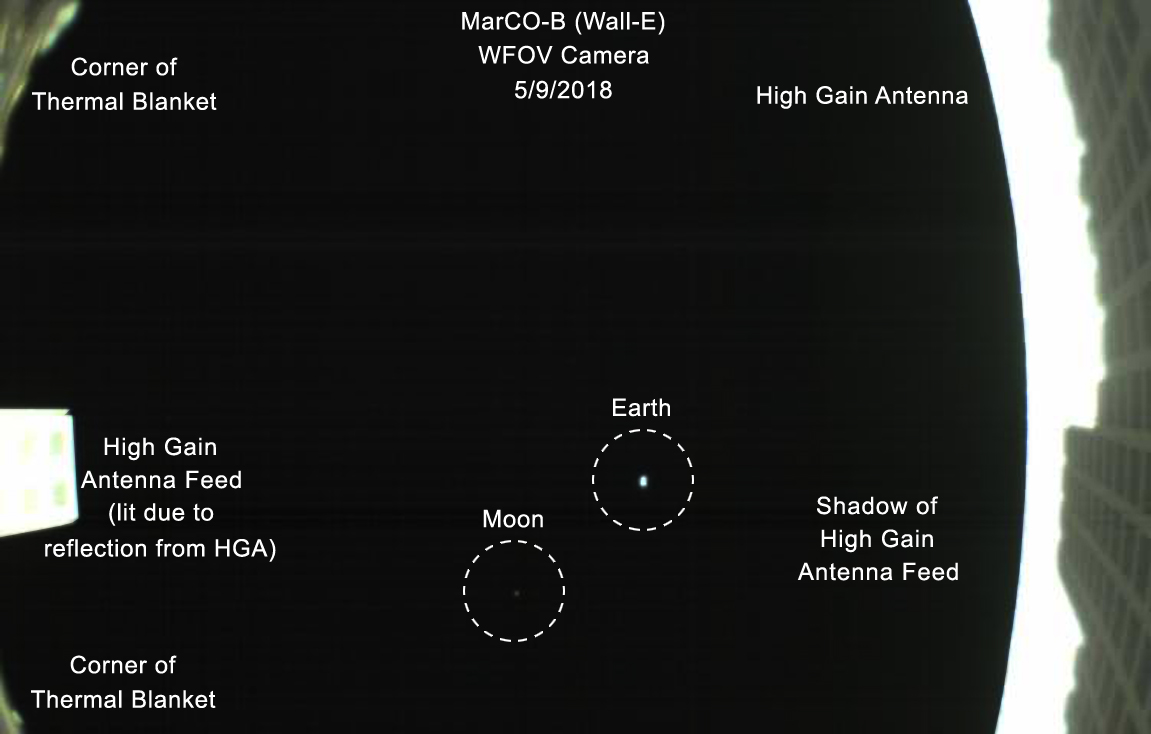See other Science/Tech Articles
Title: Tiny, Mars-Bound Satellite Snaps Its First Image of Earth and the Moon
Source:
[None]
URL Source: https://www.space.com/40599-mars-cubesat-earth-moon-photo.html
Published: May 16, 2018
Author: Mike Wall
Post Date: 2021-10-01 07:41:05 by BTP Holdings
Keywords: None
Views: 3227
Comments: 28
Tiny, Mars-Bound Satellite Snaps Its First Image of Earth and the Moon By Mike Wall | May 16, 2018 The Earth and moon star in this first photo from Wall-E, one of NASA's two Mars Cube One cubesats, that launched with the agency's InSight Mars lander on May 5, 2018. This view of Earth and the moon was taken May 9. (Image credit: NASA/JPL-Caltech) A tiny satellite on its way to Mars has opened its eyes and captured a view of home. One of NASA's two Mars Cube One (MarCO) cubesats, which launched toward the Red Planet along with the agency's InSight lander on May 5, took a photo on May 9 to help confirm that its high-gain antenna had deployed properly. The antenna is in the photo. And so are the moon and Earth, the latter of which appears as a pale blue dot, just as it did in a famous photo taken by NASA's Voyager 1 probe in 1990. [Launch Photos: See NASA's InSight Soar Toward Mars] "Consider it our homage to Voyager," MarCO chief engineer Andy Klesh, of NASA's Jet Propulsion Laboratory (JPL) in Pasadena, California, said in a statement. "Cubesats have never gone this far into space before, so it's a big milestone. Both our cubesats are healthy and functioning properly. We're looking forward to seeing them travel even farther." www.space.com/40599-mars-...at-earth-moon-photo.html?jwsource=cl Despite the "pale blue dot" photos' similarity, the two cubesats, known as MarCO-A and MarCO-B, are nowhere near as far afield as Voyager 1 was back in 1990. The older probe took its iconic image from a distance of about 3.7 billion miles (6 billion kilometers), whereas the two cubesats were about 620,000 miles (1 million km) from Earth on May 8, the day before MarCO-B snapped the newly released image, NASA officials said. Cubesats are becoming relatively common in Earth orbit, where they test various technologies, study and image Earth, and perform a number of other tasks. But none of these tiny craft had ever ventured into deep space until the twin MarCO spacecraft did. The first photo captured by one of NASA's two Mars Cube One (MarCO) cubesats, which launched along with the agency's InSight lander on May 5, 2018. The image, which shows the cubesat's unfolded high-gain antenna at right and Earth and the moon in the center, was acquired by the cubesat, dubbed MarCO-B, on May 9. (Image credit: NASA/JPL-Caltech) MarCO-A and MarCO-B, which were built at JPL, are conducting a demonstration mission — basically, their handlers aim to show that cubesats can indeed help explore distant destinations. They're also testing a few specific technologies, including a propulsion system that uses the same cold, compressed gas commonly found in fire extinguishers. (This detail explains the duo's nicknames, Wall-E and Eva. In the 2008 film "Wall-E," the titular robot uses a fire extinguisher to zoom around in space while his friend Eva looks on. And, in case you're wondering, MarCO-A is Eva, and MarCO-B is Wall- E.) If all goes according to plan, MarCO-A and -B will fly by Mars on Nov. 26, the same day that InSight arrives at the Red Planet for its crucial entry, descent and landing (EDL) sequence. The MarCO team wants the cubesats to help relay InSight's EDL data back to mission control on Earth, but this isn't a vital aspect of the lander's mission; NASA's Mars Reconnaissance Orbiter will perform this relay function as well. The MarCO craft will undergo a long-distance health check within a few weeks of the Mars flyby, and then the mission will be over, team members have said. InSight's work, however, will just be beginning. The lander — whose name is short for "Interior Exploration using Seismic Investigations, Geodesy and Heat Transport" — will perform three different experiments to investigate Mars' internal structure and composition over its roughly two-Earth-year prime mission. InSight's observations should help researchers better understand how rocky planets form and evolve, NASA officials have said. 
Post Comment Private Reply Ignore Thread
Top • Page Up • Full Thread • Page Down • Bottom/Latest
Begin Trace Mode for Comment # 21.
#1. To: BTP Holdings, NASA Fanboi Stooges (#0)
It is unbelievable that ANY sane person still buys ANY of this comical NASA / Disney $52 million per day CGI / Gaslight Operation. Hey BTP -- NASA has already repeatedly echoed the FACT that they can NOT LEAVE LOW EARTH ORBIT. What say YOU and the other Stooges?
I confess to giving myself an early birthday present by moving the Liberator to the Bozo list.
Welcome to the club.
There are no replies to Comment # 21. End Trace Mode for Comment # 21.
Top • Page Up • Full Thread • Page Down • Bottom/Latest
#2. To: Liberator (#1)
Did someone say Stooges? What's the matter Liberator, all your Langley friends leave you at the dance with a torn gown and mascara streaming down your cheeks?
#20. To: Dakmar (#2)
#21. To: Lod (#20)
Replies to Comment # 21.